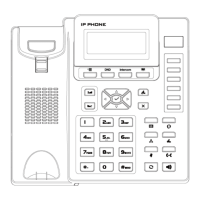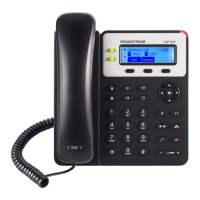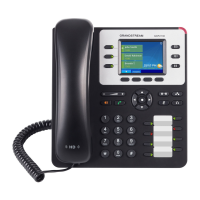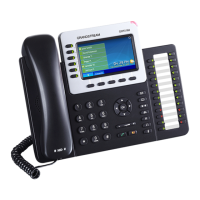Grandstream Networks, Inc. GXP User Manual Page 39 of 44
Firmware 1.2.5.3 Last Updated: 03/2011
SUBSCRIBE for
Registration Event
Default is No. This is mainly used for IMS purposes. When enabled, the terminals
should store the Service-Route header values after successfully registered, and
thereafter add a route header with the values stored in the Service-Route when
initiating a request excluding REGISTER.
SIP Extension to notify SIP server that the unit is behind the NAT/Firewall.
When configured, user can access messages by pressing “MSG” button. This ID
is usually the VM portal access number.
This parameter specifies the mechanism to transmit DTMF digit. There are 3
supported modes: in audio which means DTMF is combined in audio signal (not
very reliable with low-bit-rate codec), via RTP (RFC2833), or via SIP INFO.
Default is No. Use only if proxy supports 484 responses.
Sets the prefix added to each dialed number.
Default is ‘**”. This prefix is prepended when answering call with BLF key.
Delayed Call Forward
Wait Time
Time waited before the call is forward to a number or VM.
Default is 20 seconds.
Default is Yes. If set to “No”, Call transfer, Call Forwarding & Do-Not-Disturb are
supported locally provided ITSP support those features. In addition, “ForwardAll”
softkey will be hidden if call feature code is disabled for Account 1.
User can choose to disable Call Log and what kind of calls to log.
The SIP Session Timer extension enables SIP sessions to be periodically
“refreshed” via a SIP request (UPDATE, or re-INVITE. Once the session interval
expires, if there is no refresh via a UPDATE or re-INVITE message, the session is
terminated.
Session Expiration is the time (in seconds) at which the session is considered
timed out, provided no successful session refresh transaction occurs beforehand.
The default value is 180 seconds.
Defines the minimum session expiration (in seconds). Default is 90 seconds.
If set to “Yes”, the phone will use session timer when it makes outbound calls if
remote party supports session timer.
If selecting “Yes”, the phone will use session timer when it receives inbound calls
with session timer request.
If set to “Yes”, the phone will use session timer even if the remote party does not
support this feature. If set to “No”, the session timer is enabled only when the
remote party supports this feature. To turn off Session Timer, select “No” for
Caller Request Timer, Callee Request Timer, and Force Timer.
As a Caller, select UAC to use the phone as the refresher, or UAS to use the
Callee or proxy server as the refresher.
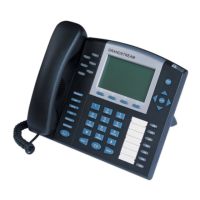
